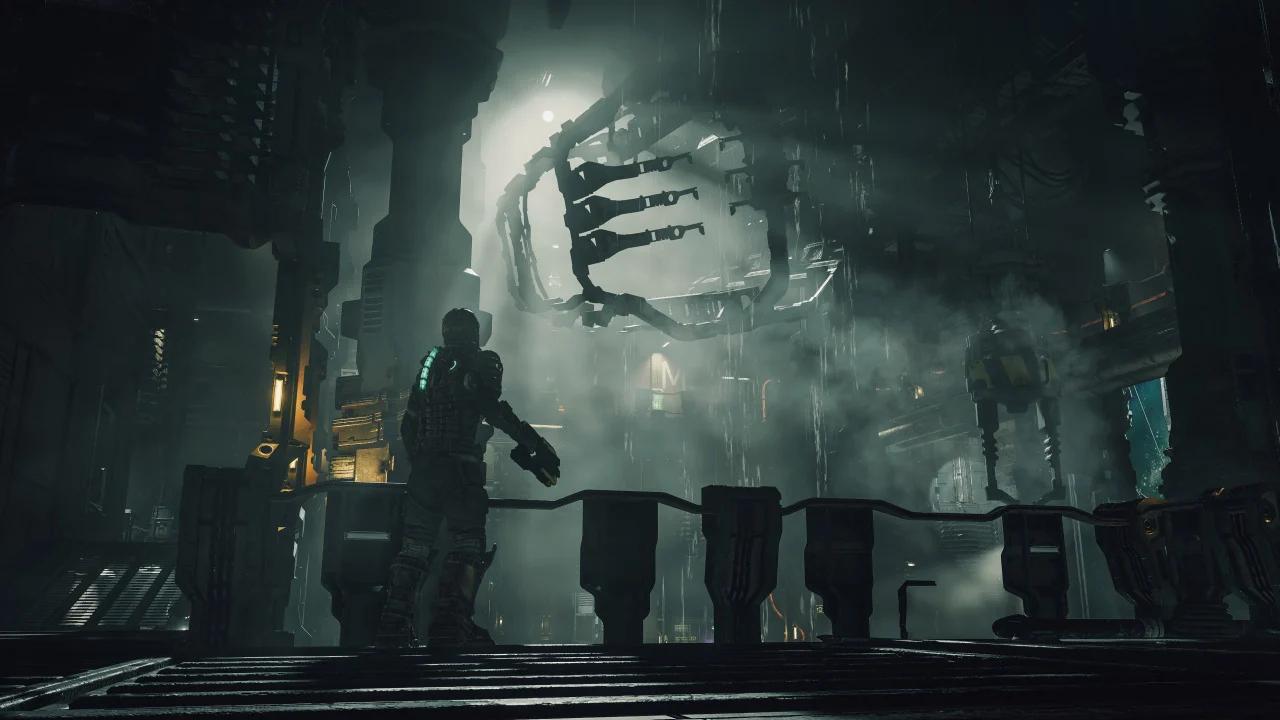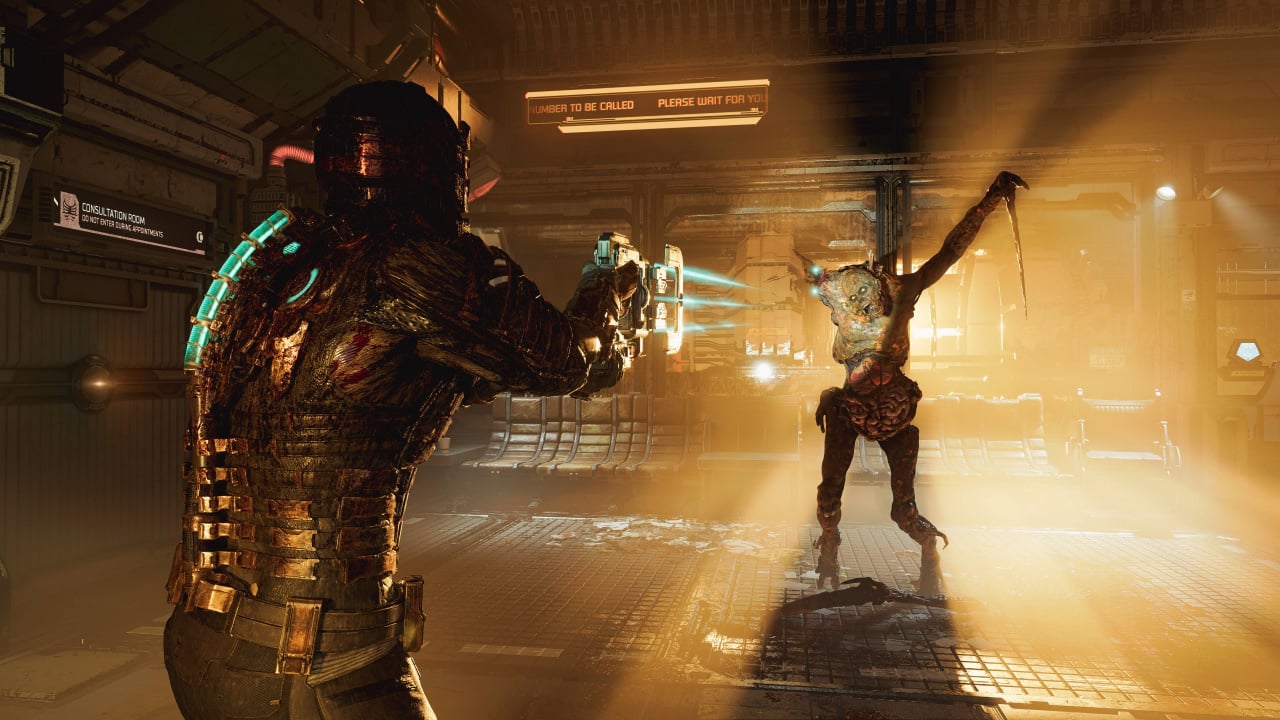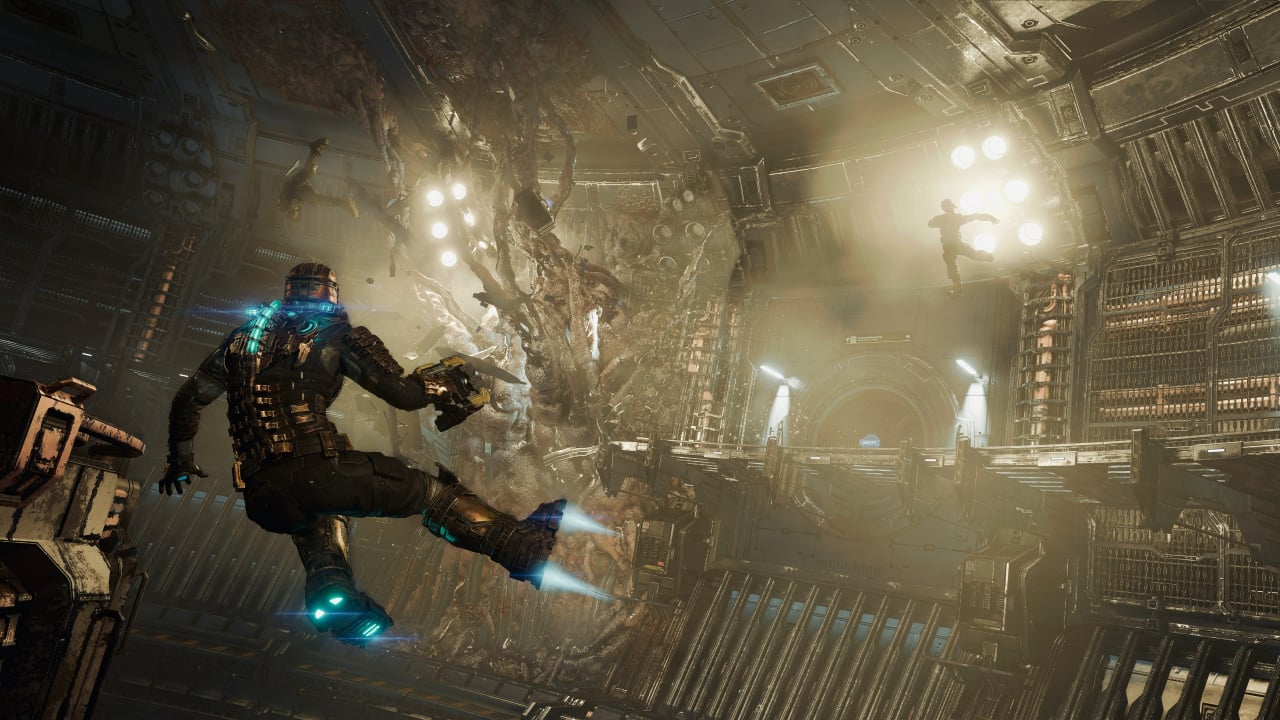Dead Space review – a remake to rival Resident Evil 2

Dismemberment, blood, gore, vomit, and death. This isn’t just a fitting description of the UK nightlife, it’s also a snippet of the content warning that pops up at the start of the Dead Space remake, threatening you with a good time. The original game had all of this, too, but now all those bodily fluids are rendered so painstakingly that you can almost smell them.
Dead Space sees you step into the armor of Isaac Clarke, a starship engineer who gets stranded on a planet-cracking mining ship called the USG Ishimura, which means ‘Stone Village’. It’s a huge space – with medical areas, living quarters, and work zones – where some people work and live for life. When Isaac and his crew arrive, it’s clear something is wrong – firstly because there’s no one around, and secondly, because humanoid creatures with gangly limbs start stabbing everyone up. After your own ship gets destroyed, you have to find a way to escape while avoiding getting stabbed up yourself.
It’s a classic survival horror game, asking you to manage an inventory and master a web of corridors while fighting off the necromorph enemies, solving the occasional puzzle along the way. This remake reconfirms the original game’s brilliance without taking anything away from it. In fact, it adds a bunch – new puzzles, more upgrade options for your weapons, better enemy AI, and a New Game+ mode where you can unlock even better upgrades and an all-new bonus ending.
“Dismemberment” might sound like it’s just an edgy content warning, but it’s actually a key game mechanic. As the game’s infamous blood graffiti tells you, these enemies don’t go down with simple headshots. No. You have to lop off their limbs.

Rather than your usual range of murder tools, you’re kitted out with mining lasers, a telekinetic glove, and other industrial appliances, all with creative, effective uses. You can use the mining laser to become a macabre surgeon, slicing off limbs with precision, pull out the flamethrower to melt skin or block off doorways with a wall of flames, or, my personal favorite, blast them away (and usually into tiny giblets) with the force gun. And even if you miss the limbs, every shot peels away flesh, exposing bone and sinew. Yum yum.
‘Chunky’ is how I’d describe it. Everything in Dead Space feels heavy, from the whirring machinery in the mining deck to Isaac himself. Kitted out with an armor-plated space suit, your movement speed is limited, but that’s offset by how deadly you are if you use your kit wisely. Since the necromorphs are reanimated humans, mutated by the effects of an alien artifact called The Marker, they don’t always stay dead, so you’ll be using that weight to make sure they are. Whenever you’re not aiming, pulling the trigger prompts Isaac to stomp the ground – do this on a necromorph corpse and they’ll split open, spilling useful items from their insides like a meat piñata.
The stomp does lead to some weird dissonance, though. You might see a crew member die in front of you – sad, eh? – and your first instinct will be to mush up their corpse in case they come back to life. Whenever a clean-up crew comes through, I’ll have a lot of questions to answer about the headless, limbless torsos littered around the Ishimura. “Honestly, guv, they were already dead. No, you can’t look at the underside of my boot.”
There’s a kind of language people who play games build up over time, like understanding that anything colored yellow is likely the level designer reassuring you that you’re going in the right direction. That fluency has made some of Dead Space’s old tricks slightly less effective. As I said above, any time I see a corpse – human or otherwise – it’s getting desecrated. Sorry, Jesus, but nobody is jump-scaring me with a corpse springing to life.

Little things like that stop Dead Space short of being scary for me, despite how unnerving its sound design is – ghostly whispers and the clanging of vents in an empty corridor are particularly unsettling – but there’s a surprising amount that holds up extremely well. You might think you’ve escaped a necromorph by heading through a door, only for it to climb through the vents and pop up right next to you. Horrible and brilliant.
Then there’s the diegetic UI. Rather than plastering your screen with health bars and maps, every bit of information you need is baked into Isaac’s suit. His health is represented by a series of glowing lights down his spine, and most of the other menus and usual HUD bits are projected as a hologram whenever you need them. Still excellent. It really sucks you into these claustrophobic spaces.
Level design is also still top. There are multiple regions of the Ishimura and once the game opens up, you’re able to travel between them by tram. Whenever you’re lost, you can always press a button to point to the next objective, but it’s a real interconnected space full of optional places to explore, and it feels like getting lost in the bowels of this behemoth. There are also a few moments when the story takes you outside, where you get a sense of how tiny you are against the vast expanse of space and the hulking hull of the Ishimura. The zero-gravity movement has also been updated for this remake, allowing those moments when your feet aren’t on the ground to properly soar.
It has some surprisingly inventive ideas too – most of which I’d forgotten about by the time I played this shiny, new version. Clearing a mining deck of asteroid chunks with your grav glove, avoiding being melted in filtration tubes, fixing up a comms array by freezing machinery before cutting the power. It’s not all stomping and limb-lopping. Even if you’ve stomped down these corridors before, it’s almost as if you never did.

Speaking of revisiting your old haunts, you’re encouraged to backtrack a lot to complete side missions and get items as you unlock new levels of security access. It might sound like a chore on paper, but it all feeds into the familiarity of the play space, which is one of the things that makes games like Resident Evil so replayable. You come to know the Ishimura, just as it comes to know you.
With a new AI system, the game is able to throw up random elements when you revisit areas. The AI director might make the lights go out, or cause a vent to spin off the wall, or it could throw a wave of necromorphs at you. You’re never safe, even when you’ve cleared an area out once before, which means you’re always engaged. It’s a smart addition.
In other new features, Isaac talks now. He was mute in the original game, but he chats to crewmates on comms this time around, and often he’s the one suggesting the next course of action, with him being the only guy who’s qualified to fix up an escape vehicle. He doesn’t quip like Nathan Drake and only talks when it makes sense, so it’s all-good, even if he is a little generic in terms of delivery. That face of his, too. He just looks like your mate’s dad. He looks like his name is Norman. It makes sense for him to be an everyman, but he’s pretty chill about all the blood, vomit, etc.
Of course, it looks gorgeous. I won’t spend too long banging on about graphics because there’s literally a video at the top of this page, but modern advancements in lighting really lend themselves to this setting, with the brushed metal of your suit and the ship reflecting light. The darkness is actually dark, too, adding to the tension when you’re guided only by torchlight. In a nice touch, the lighting occasionally comes into play in combat, with red emergency lights strobing, illuminating the creatures closing in on you, getting nearer and nearer with every blink.
Being a predominantly single-player enjoyer, it’s been a while since I’ve really loved a game from EA, but this is a true return to form. It might not be entirely new, but it’s the kind of remake that people will talk about with the same reverence as Resident Evil 2. All yours if you can stomach a bit of blood, gore, vomit, and death.
Score: 9/10
Version tested: PS5.
